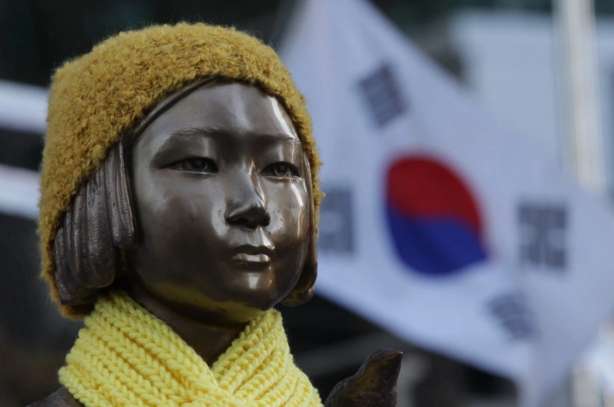This agreement is a surprising but positive development in relations between Japan and South Korea, two major U.S. allies whose shared history has been deeply troubled. In a sign of how seriously both sides are taking this moment, Tokyo and Seoul have said that the new deal had “finally and irreversibly” resolved the dispute over wartime sex slaves.
However, one very visceral reminder of the terrible history sits in the middle of Seoul, outside the Japanese Embassy. A life-size bronze statue of a barefoot girl, symbolizing a "comfort woman," was erected in December 2011 to honor the 1,000th weekly Wednesday demonstration outside the embassy by survivors and their supporters.
The empty chair next to the statue is said to symbolize the survivors who have passed away while waiting for a full apology from Japan. (Japan officially apologized for its colonial-era use of sex slaves in 1993, though many critics said this was not enough.)
Japanese authorities have long asked that the statue be moved, saying that it contravenes the Vienna Convention on Diplomatic Relations, which calls for host countries to protect diplomatic missions.
However, South Korean authorities have defended the statue and its placement.
“The victims are over 80 years old and passing away, and the government is not in a position to tell them to remove the statue,” Cho Byung-jae, a spokesman for South Korea’s Foreign Ministry, told the New York Times when the statue was unveiled. “Rather than insisting on the removal of the statue, the Japanese government should seriously ask itself why these victims have held their weekly rallies for 20 years, never missing a week, and whether it really cannot find a way to restore the honor these woman so earnestly want.”
Since that monument was unveiled, more have followed it — including one in Virginia`s Fairfax County. The statue and others like it have helped spur new attempts to force another apology from Japan to South Korea`s wartime sex slaves.
With the new agreement between Japan and South Korea, the future of the statue in Seoul is unclear. The Chosun Ilbo, a Seoul-based newspaper, writes that a clause in the statement signed by the two parties on Monday suggests that it could be removed.
According to Japan`s Yomiuri Shimbun newspaper, Japanese Prime Minister Shinzo Abe has insisted that the statue be removed. But South Korean Foreign Minister Yun Byung-se is reported to have told journalists that the issue would be resolved "by negotiating with relevant civic groups."
Some of these civic groups are incensed by the ambiguity about the statue`s future. "It is a public property and a historic symbol representing the peaceful spirit of the Wednesday Demonstrations, which has been continued by the survivors and the citizens for over a thousand Wednesdays," the Korean Council for the Women Drafted for Military Sexual Slavery by Japan said in a statement. "The Korean government cannot mention anything about the removal or moving of the Monument."
Although Japan may not immediately push for the removal of the statue, its eventual fate will be important in a country where many feel they have apologized enough for past crimes.
"It is not something that friendly nations normally do," an unnamed former Japanese diplomat told the news agency Reuters.
More about:















































